Foreign Direct Investment (FDI) Analysis: UAE Case Study
VerifiedAdded on 2022/09/07
|6
|1336
|27
Homework Assignment
AI Summary
This homework assignment analyzes Foreign Direct Investment (FDI), defining it as investment by a firm from one country into a business in another. It emphasizes FDI's importance for economic development, including capital augmentation, technology transfer, and employment growth, benefiting both the investing company and the host country through tax incentives and market expansion. The assignment explores company motivations for FDI, such as avoiding trade barriers and reducing production costs. It also highlights the top sectors attracting FDI in the UAE (retail, wholesale, accommodation, food services, administration and support services, software publishers, and finance and insurance) and the government's initiatives to attract more investment. The document discusses the positive and negative lists of FDI in the UAE, which dictate sectors open or restricted to foreign investment, and their impact on investment flow. The UAE's success in attracting FDI and the recent FDI law are also discussed.
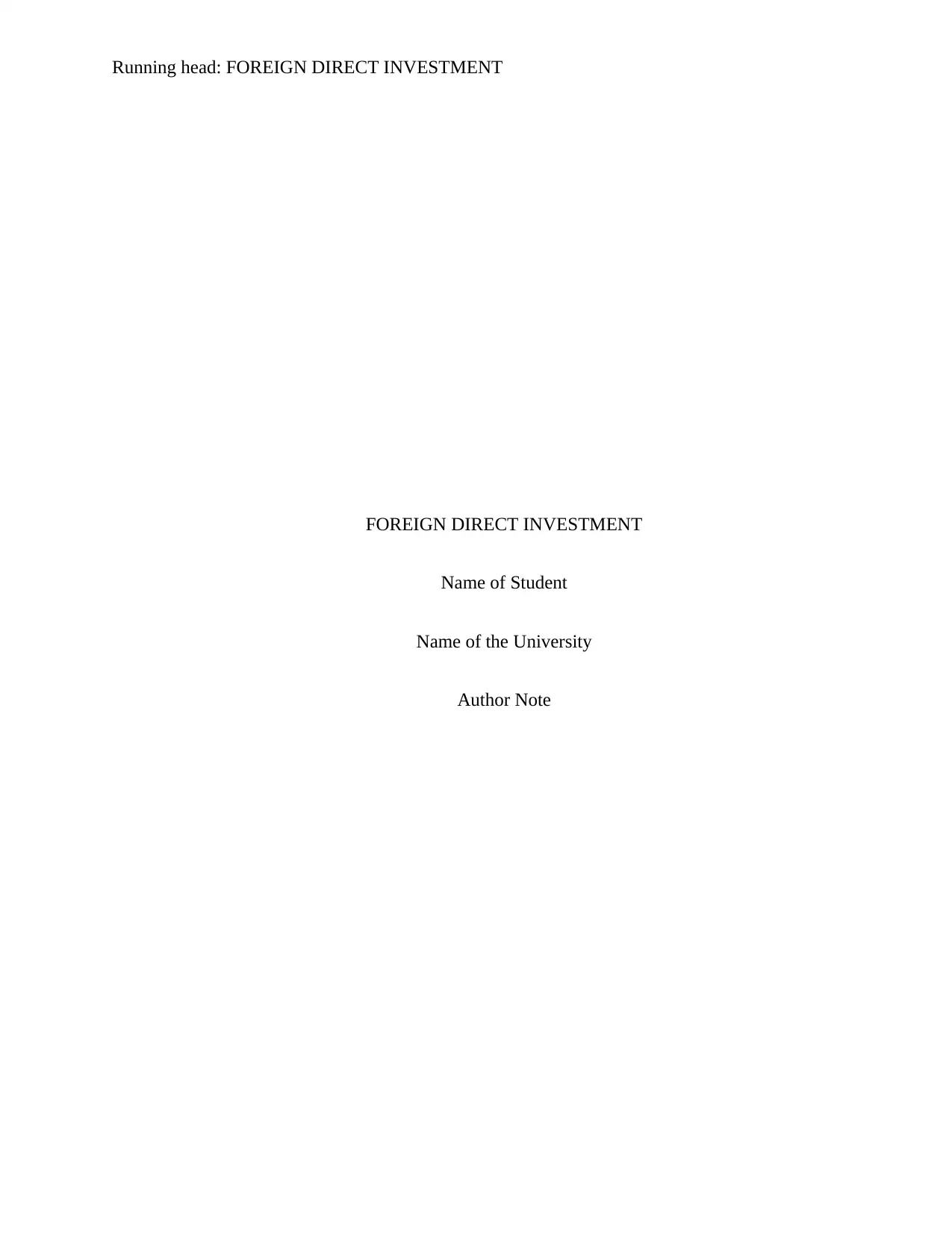
Running head: FOREIGN DIRECT INVESTMENT
FOREIGN DIRECT INVESTMENT
Name of Student
Name of the University
Author Note
FOREIGN DIRECT INVESTMENT
Name of Student
Name of the University
Author Note
Paraphrase This Document
Need a fresh take? Get an instant paraphrase of this document with our AI Paraphraser
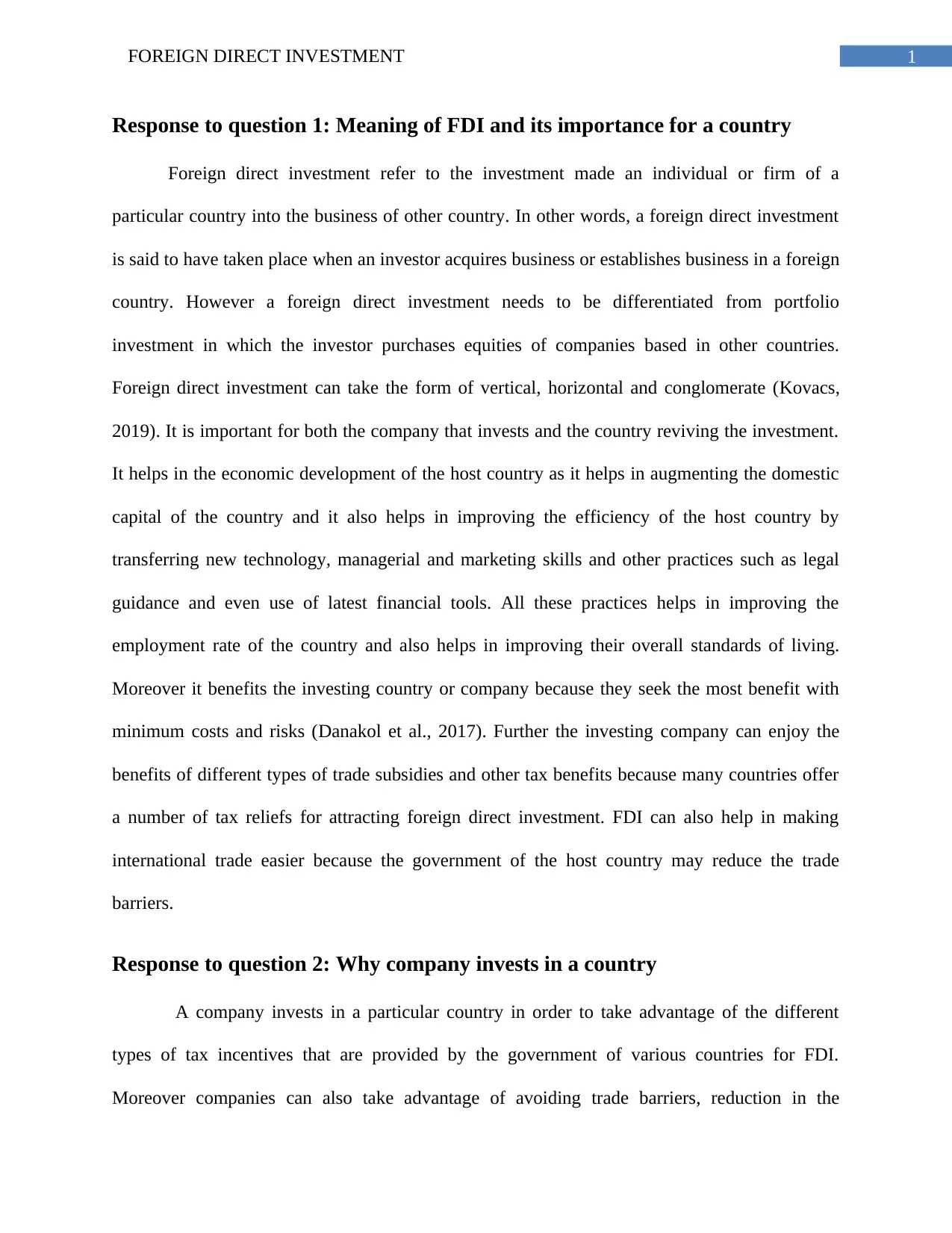
1FOREIGN DIRECT INVESTMENT
Response to question 1: Meaning of FDI and its importance for a country
Foreign direct investment refer to the investment made an individual or firm of a
particular country into the business of other country. In other words, a foreign direct investment
is said to have taken place when an investor acquires business or establishes business in a foreign
country. However a foreign direct investment needs to be differentiated from portfolio
investment in which the investor purchases equities of companies based in other countries.
Foreign direct investment can take the form of vertical, horizontal and conglomerate (Kovacs,
2019). It is important for both the company that invests and the country reviving the investment.
It helps in the economic development of the host country as it helps in augmenting the domestic
capital of the country and it also helps in improving the efficiency of the host country by
transferring new technology, managerial and marketing skills and other practices such as legal
guidance and even use of latest financial tools. All these practices helps in improving the
employment rate of the country and also helps in improving their overall standards of living.
Moreover it benefits the investing country or company because they seek the most benefit with
minimum costs and risks (Danakol et al., 2017). Further the investing company can enjoy the
benefits of different types of trade subsidies and other tax benefits because many countries offer
a number of tax reliefs for attracting foreign direct investment. FDI can also help in making
international trade easier because the government of the host country may reduce the trade
barriers.
Response to question 2: Why company invests in a country
A company invests in a particular country in order to take advantage of the different
types of tax incentives that are provided by the government of various countries for FDI.
Moreover companies can also take advantage of avoiding trade barriers, reduction in the
Response to question 1: Meaning of FDI and its importance for a country
Foreign direct investment refer to the investment made an individual or firm of a
particular country into the business of other country. In other words, a foreign direct investment
is said to have taken place when an investor acquires business or establishes business in a foreign
country. However a foreign direct investment needs to be differentiated from portfolio
investment in which the investor purchases equities of companies based in other countries.
Foreign direct investment can take the form of vertical, horizontal and conglomerate (Kovacs,
2019). It is important for both the company that invests and the country reviving the investment.
It helps in the economic development of the host country as it helps in augmenting the domestic
capital of the country and it also helps in improving the efficiency of the host country by
transferring new technology, managerial and marketing skills and other practices such as legal
guidance and even use of latest financial tools. All these practices helps in improving the
employment rate of the country and also helps in improving their overall standards of living.
Moreover it benefits the investing country or company because they seek the most benefit with
minimum costs and risks (Danakol et al., 2017). Further the investing company can enjoy the
benefits of different types of trade subsidies and other tax benefits because many countries offer
a number of tax reliefs for attracting foreign direct investment. FDI can also help in making
international trade easier because the government of the host country may reduce the trade
barriers.
Response to question 2: Why company invests in a country
A company invests in a particular country in order to take advantage of the different
types of tax incentives that are provided by the government of various countries for FDI.
Moreover companies can also take advantage of avoiding trade barriers, reduction in the
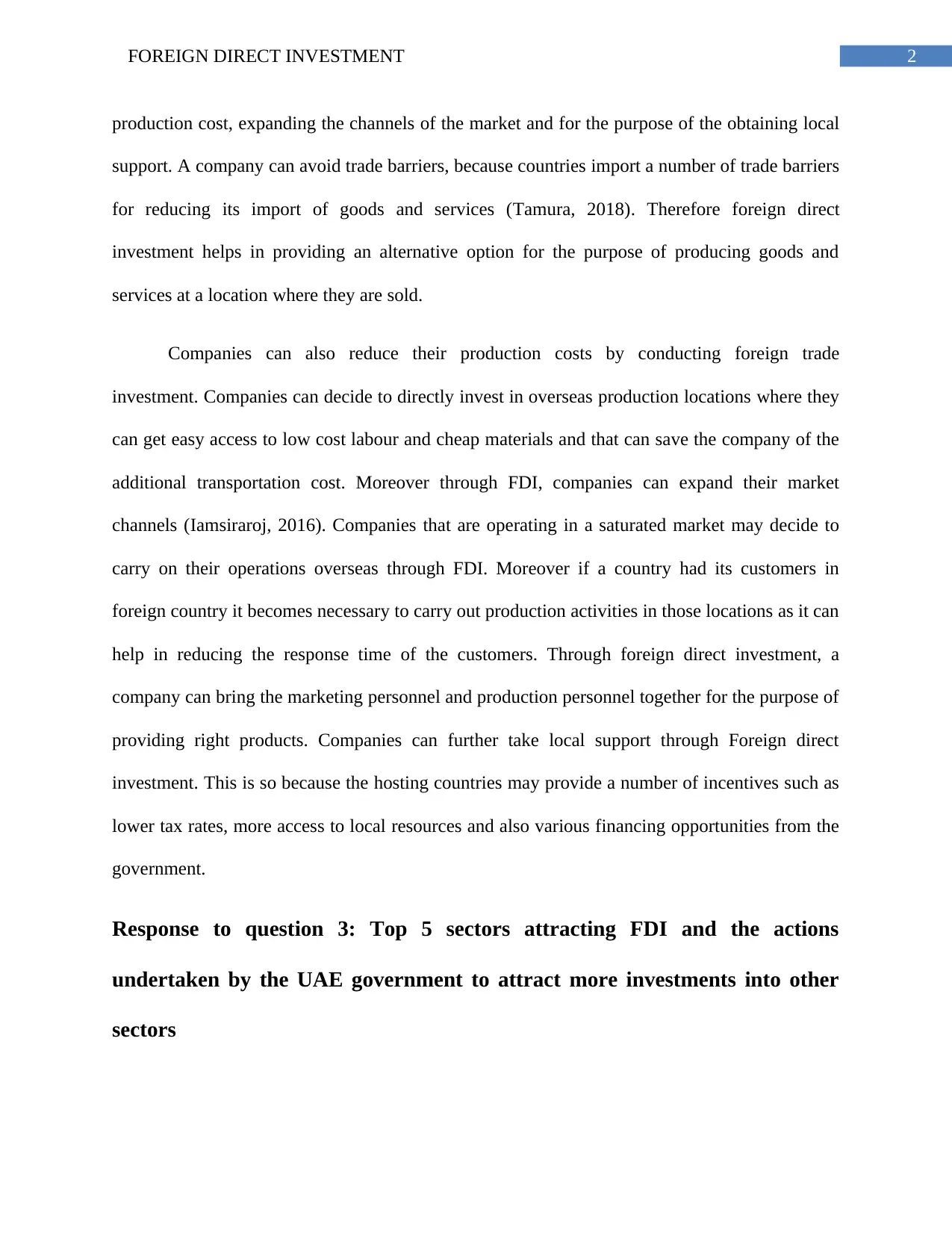
2FOREIGN DIRECT INVESTMENT
production cost, expanding the channels of the market and for the purpose of the obtaining local
support. A company can avoid trade barriers, because countries import a number of trade barriers
for reducing its import of goods and services (Tamura, 2018). Therefore foreign direct
investment helps in providing an alternative option for the purpose of producing goods and
services at a location where they are sold.
Companies can also reduce their production costs by conducting foreign trade
investment. Companies can decide to directly invest in overseas production locations where they
can get easy access to low cost labour and cheap materials and that can save the company of the
additional transportation cost. Moreover through FDI, companies can expand their market
channels (Iamsiraroj, 2016). Companies that are operating in a saturated market may decide to
carry on their operations overseas through FDI. Moreover if a country had its customers in
foreign country it becomes necessary to carry out production activities in those locations as it can
help in reducing the response time of the customers. Through foreign direct investment, a
company can bring the marketing personnel and production personnel together for the purpose of
providing right products. Companies can further take local support through Foreign direct
investment. This is so because the hosting countries may provide a number of incentives such as
lower tax rates, more access to local resources and also various financing opportunities from the
government.
Response to question 3: Top 5 sectors attracting FDI and the actions
undertaken by the UAE government to attract more investments into other
sectors
production cost, expanding the channels of the market and for the purpose of the obtaining local
support. A company can avoid trade barriers, because countries import a number of trade barriers
for reducing its import of goods and services (Tamura, 2018). Therefore foreign direct
investment helps in providing an alternative option for the purpose of producing goods and
services at a location where they are sold.
Companies can also reduce their production costs by conducting foreign trade
investment. Companies can decide to directly invest in overseas production locations where they
can get easy access to low cost labour and cheap materials and that can save the company of the
additional transportation cost. Moreover through FDI, companies can expand their market
channels (Iamsiraroj, 2016). Companies that are operating in a saturated market may decide to
carry on their operations overseas through FDI. Moreover if a country had its customers in
foreign country it becomes necessary to carry out production activities in those locations as it can
help in reducing the response time of the customers. Through foreign direct investment, a
company can bring the marketing personnel and production personnel together for the purpose of
providing right products. Companies can further take local support through Foreign direct
investment. This is so because the hosting countries may provide a number of incentives such as
lower tax rates, more access to local resources and also various financing opportunities from the
government.
Response to question 3: Top 5 sectors attracting FDI and the actions
undertaken by the UAE government to attract more investments into other
sectors
⊘ This is a preview!⊘
Do you want full access?
Subscribe today to unlock all pages.

Trusted by 1+ million students worldwide
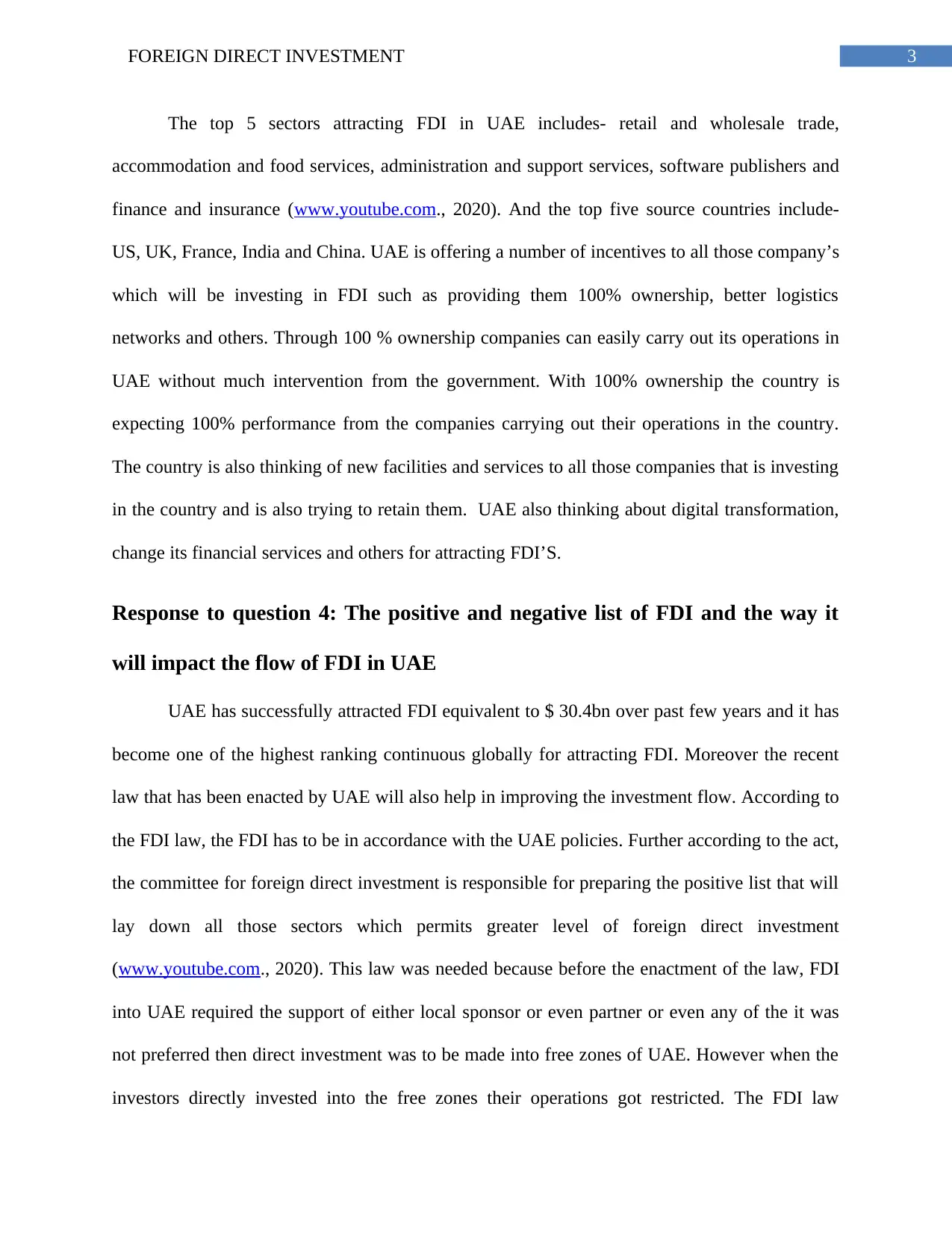
3FOREIGN DIRECT INVESTMENT
The top 5 sectors attracting FDI in UAE includes- retail and wholesale trade,
accommodation and food services, administration and support services, software publishers and
finance and insurance (www.youtube.com., 2020). And the top five source countries include-
US, UK, France, India and China. UAE is offering a number of incentives to all those company’s
which will be investing in FDI such as providing them 100% ownership, better logistics
networks and others. Through 100 % ownership companies can easily carry out its operations in
UAE without much intervention from the government. With 100% ownership the country is
expecting 100% performance from the companies carrying out their operations in the country.
The country is also thinking of new facilities and services to all those companies that is investing
in the country and is also trying to retain them. UAE also thinking about digital transformation,
change its financial services and others for attracting FDI’S.
Response to question 4: The positive and negative list of FDI and the way it
will impact the flow of FDI in UAE
UAE has successfully attracted FDI equivalent to $ 30.4bn over past few years and it has
become one of the highest ranking continuous globally for attracting FDI. Moreover the recent
law that has been enacted by UAE will also help in improving the investment flow. According to
the FDI law, the FDI has to be in accordance with the UAE policies. Further according to the act,
the committee for foreign direct investment is responsible for preparing the positive list that will
lay down all those sectors which permits greater level of foreign direct investment
(www.youtube.com., 2020). This law was needed because before the enactment of the law, FDI
into UAE required the support of either local sponsor or even partner or even any of the it was
not preferred then direct investment was to be made into free zones of UAE. However when the
investors directly invested into the free zones their operations got restricted. The FDI law
The top 5 sectors attracting FDI in UAE includes- retail and wholesale trade,
accommodation and food services, administration and support services, software publishers and
finance and insurance (www.youtube.com., 2020). And the top five source countries include-
US, UK, France, India and China. UAE is offering a number of incentives to all those company’s
which will be investing in FDI such as providing them 100% ownership, better logistics
networks and others. Through 100 % ownership companies can easily carry out its operations in
UAE without much intervention from the government. With 100% ownership the country is
expecting 100% performance from the companies carrying out their operations in the country.
The country is also thinking of new facilities and services to all those companies that is investing
in the country and is also trying to retain them. UAE also thinking about digital transformation,
change its financial services and others for attracting FDI’S.
Response to question 4: The positive and negative list of FDI and the way it
will impact the flow of FDI in UAE
UAE has successfully attracted FDI equivalent to $ 30.4bn over past few years and it has
become one of the highest ranking continuous globally for attracting FDI. Moreover the recent
law that has been enacted by UAE will also help in improving the investment flow. According to
the FDI law, the FDI has to be in accordance with the UAE policies. Further according to the act,
the committee for foreign direct investment is responsible for preparing the positive list that will
lay down all those sectors which permits greater level of foreign direct investment
(www.youtube.com., 2020). This law was needed because before the enactment of the law, FDI
into UAE required the support of either local sponsor or even partner or even any of the it was
not preferred then direct investment was to be made into free zones of UAE. However when the
investors directly invested into the free zones their operations got restricted. The FDI law
Paraphrase This Document
Need a fresh take? Get an instant paraphrase of this document with our AI Paraphraser
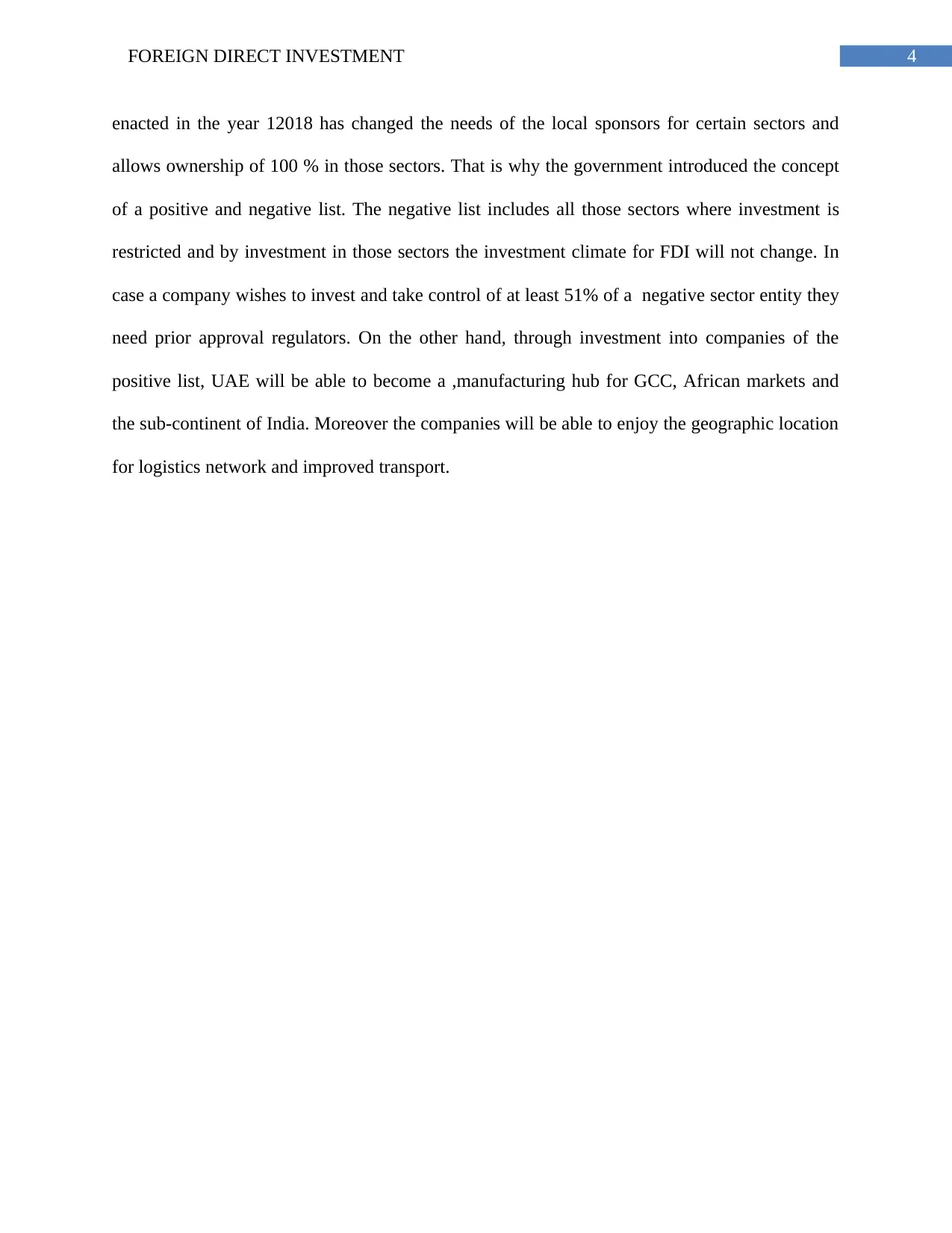
4FOREIGN DIRECT INVESTMENT
enacted in the year 12018 has changed the needs of the local sponsors for certain sectors and
allows ownership of 100 % in those sectors. That is why the government introduced the concept
of a positive and negative list. The negative list includes all those sectors where investment is
restricted and by investment in those sectors the investment climate for FDI will not change. In
case a company wishes to invest and take control of at least 51% of a negative sector entity they
need prior approval regulators. On the other hand, through investment into companies of the
positive list, UAE will be able to become a ,manufacturing hub for GCC, African markets and
the sub-continent of India. Moreover the companies will be able to enjoy the geographic location
for logistics network and improved transport.
enacted in the year 12018 has changed the needs of the local sponsors for certain sectors and
allows ownership of 100 % in those sectors. That is why the government introduced the concept
of a positive and negative list. The negative list includes all those sectors where investment is
restricted and by investment in those sectors the investment climate for FDI will not change. In
case a company wishes to invest and take control of at least 51% of a negative sector entity they
need prior approval regulators. On the other hand, through investment into companies of the
positive list, UAE will be able to become a ,manufacturing hub for GCC, African markets and
the sub-continent of India. Moreover the companies will be able to enjoy the geographic location
for logistics network and improved transport.
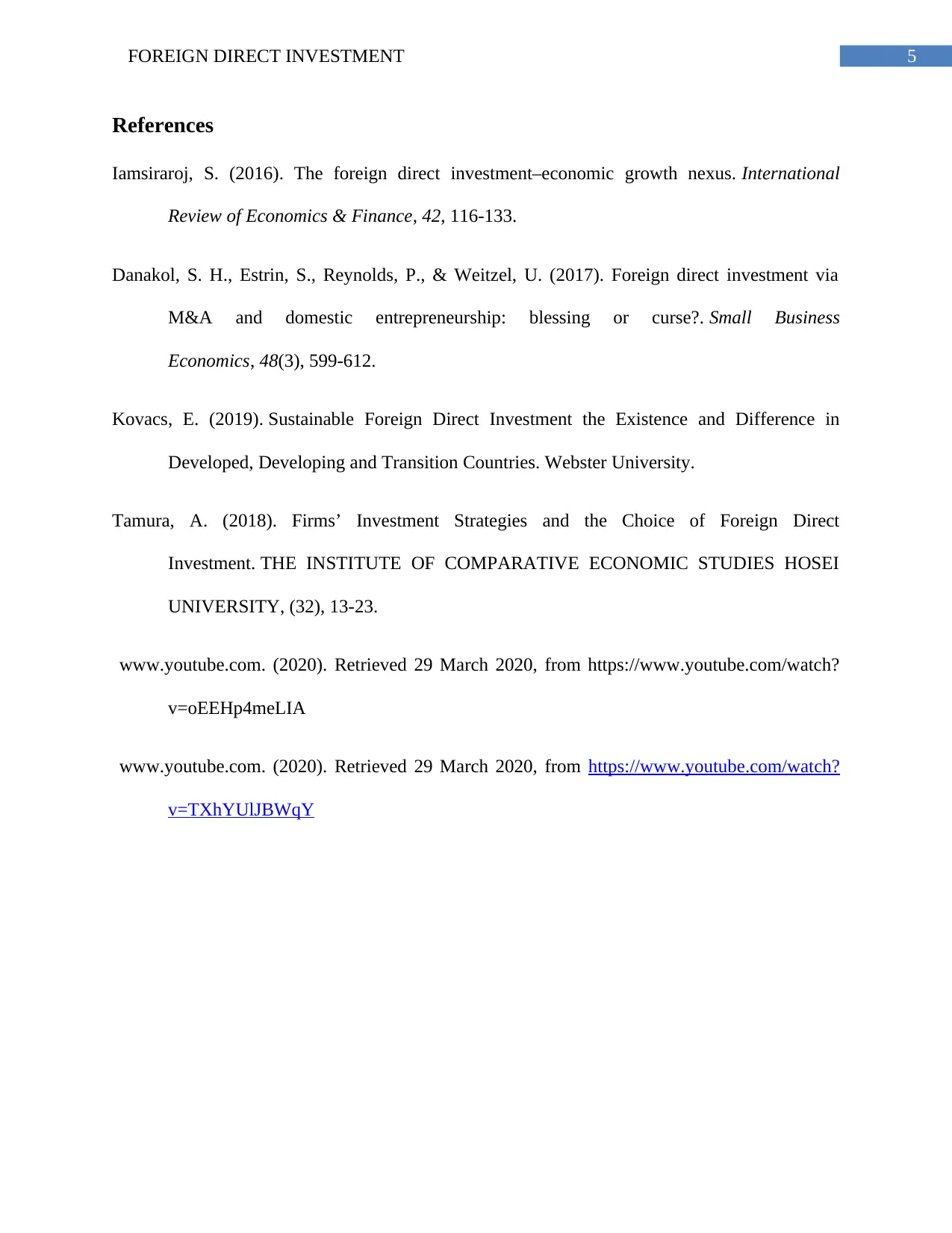
5FOREIGN DIRECT INVESTMENT
References
Iamsiraroj, S. (2016). The foreign direct investment–economic growth nexus. International
Review of Economics & Finance, 42, 116-133.
Danakol, S. H., Estrin, S., Reynolds, P., & Weitzel, U. (2017). Foreign direct investment via
M&A and domestic entrepreneurship: blessing or curse?. Small Business
Economics, 48(3), 599-612.
Kovacs, E. (2019). Sustainable Foreign Direct Investment the Existence and Difference in
Developed, Developing and Transition Countries. Webster University.
Tamura, A. (2018). Firms’ Investment Strategies and the Choice of Foreign Direct
Investment. THE INSTITUTE OF COMPARATIVE ECONOMIC STUDIES HOSEI
UNIVERSITY, (32), 13-23.
www.youtube.com. (2020). Retrieved 29 March 2020, from https://www.youtube.com/watch?
v=oEEHp4meLIA
www.youtube.com. (2020). Retrieved 29 March 2020, from https://www.youtube.com/watch?
v=TXhYUlJBWqY
References
Iamsiraroj, S. (2016). The foreign direct investment–economic growth nexus. International
Review of Economics & Finance, 42, 116-133.
Danakol, S. H., Estrin, S., Reynolds, P., & Weitzel, U. (2017). Foreign direct investment via
M&A and domestic entrepreneurship: blessing or curse?. Small Business
Economics, 48(3), 599-612.
Kovacs, E. (2019). Sustainable Foreign Direct Investment the Existence and Difference in
Developed, Developing and Transition Countries. Webster University.
Tamura, A. (2018). Firms’ Investment Strategies and the Choice of Foreign Direct
Investment. THE INSTITUTE OF COMPARATIVE ECONOMIC STUDIES HOSEI
UNIVERSITY, (32), 13-23.
www.youtube.com. (2020). Retrieved 29 March 2020, from https://www.youtube.com/watch?
v=oEEHp4meLIA
www.youtube.com. (2020). Retrieved 29 March 2020, from https://www.youtube.com/watch?
v=TXhYUlJBWqY
⊘ This is a preview!⊘
Do you want full access?
Subscribe today to unlock all pages.

Trusted by 1+ million students worldwide
1 out of 6
Related Documents
Your All-in-One AI-Powered Toolkit for Academic Success.
+13062052269
info@desklib.com
Available 24*7 on WhatsApp / Email
![[object Object]](/_next/static/media/star-bottom.7253800d.svg)
Unlock your academic potential
Copyright © 2020–2025 A2Z Services. All Rights Reserved. Developed and managed by ZUCOL.





